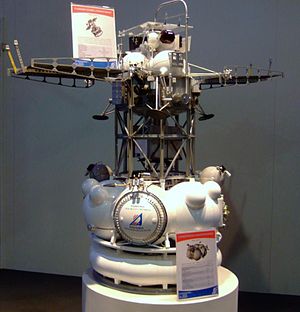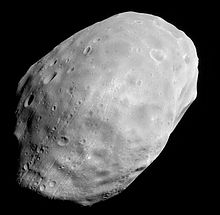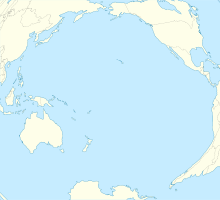Fobos-Grunt
| Fobos-Grunt | |||||||||||||
|---|---|---|---|---|---|---|---|---|---|---|---|---|---|
 Model of the Fobos-Grunt spacecraft |
|||||||||||||
| NSSDC ID | 2011-065A | ||||||||||||
| Mission goal | Martian moon Phobos | ||||||||||||
| Launcher | Zenit-2SB | ||||||||||||
| Course of the mission | |||||||||||||
| Start date | November 8, 2011, 20:16 UTC | ||||||||||||
| launch pad | TB 45/1 | ||||||||||||
|
|||||||||||||

(2) MDU drive unit
(3) Yinghuo-1
(4) Landing stage
(5) Return stage
(6) Sample vessel
Fobos-Grunt ( Russian Фобос-Грунт , English Phobos-Grunt , translated Phobos-Boden ) was a Russian spacecraft that land on the Martian moon Phobos ( Russian Фобос , transcribed Fobos ), take samples there and bring them to Earth in a small return capsule should (planned sample return mission ). Furthermore, the landing station remaining on Phobos was supposed to investigate Mars and Phobos over a longer period of time. The mission failed.
After the successful start on November 8, 2011, Fobos-Grunt found itself in a parking orbit around the earth. Since the entry into the transition orbit to Mars was not carried out because the probe was not correctly aligned, the probe could not leave the parking orbit. On January 15, 2012, the probe entered the earth's atmosphere and burned up over the Eastern Pacific.
development
The probe was developed by NPO Lavochkin . Fobos-Grunt was the first Russian mission to Mars after the unsuccessful Fobos missions and the failure of Mars 96 in 1996.
The development of the probe started in 2001, but was hardly financed until 2003, so that the originally planned start date in 2007 was not kept. It was not until 2004 that the Russian government provided sufficient funds for Fobos-Grunt so that the selection of scientific instruments and the construction of the first components could begin. At the end of 2005, a launch of the probe in October 2009 was finally targeted. Russia and the PRC discussed cooperation on this project in June 2005. In August 2006 it was confirmed by the Chinese side that there would be a cooperation. It was later announced that Fobos-Grunt would take the Chinese microsatellite Yinghuo-1 and deploy it near Mars; this should then carry out independent investigations. The task of the Chinese probe was to orbit Mars, while the Russian lander was supposed to land on the moon Phobos to take soil samples there. This lander was equipped with equipment developed by Hong Kong Polytechnic University . There were also plans to take two MetNet Mars landing probes as payloads.
The original plans provided for an ion drive for Fobos-Grunt , but this was replaced by an ordinary chemical drive . This made the probe heavier, which means that less scientific payload could be carried, but the flight time to Mars would have been reduced from about 18 to 11 months.
The launch was initially planned for October 2009. Just a few weeks before that, the mission was postponed to 2011. The reason given was the tight schedule, which did not leave enough room for extensive tests.
Course of the mission
Planned process
The transfer to Mars should take approximately 11 months. After entering Mars orbit, Fobos-Grunt should have gradually approached Phobos over a longer period of time, recording the Martian moon, but also Mars itself with their instruments.
After the probe got close enough to Phobos and its relative speed to the Martian moon had become negligibly small, it should have attempted a landing in February 2013. Landing sites were already selected when the Mars Express probe flew by in March 2010. Had the landing been successful, around 200 to 400 grams of soil samples would have been taken with a drill, which would have been stored in a small return capsule weighing eight to nine kilograms, hermetically packed. Shortly afterwards, the capsule would have been brought into Mars orbit with a return rocket weighing around 270 kg, and then launched from there towards Earth. The arrival of the capsule on Earth was planned for August 2014. The landing station that remained on Phobos would have carried out further measurements at its landing site, and it would also have been able to observe Mars from the surface of the moon.
Actual process
Fobos-Grunt was launched into low Earth orbit on November 8, 2011 at 20:16 UTC with a Zenit-2SB rocket. The probe was equipped with a drive unit derived from the Fregat upper stage called the MDU, which should have sent the space probe on its journey to Mars and should also have taken over the braking into Mars orbit. The probe, including the MDU drive unit, had a mass of 13,200 kg with fuel. Due to a mistake, however, on November 8, 2011, the launch into the Mars transfer orbit was not carried out and the probe remained in earth orbit.
However, neither Fobos-Grunt nor the ground stations were designed for communication in low earth orbit. Contact from the Russian stations was unsuccessful, control commands could not be transmitted, nor were telemetry data received. In low earth orbit, a flight over a ground station only takes a few minutes. Strongly bundling satellite antennas also have to be adjusted during this time in order to establish a connection to the probe. For this reason, modifications were made to a 15 m ESTRACK antenna by ESA near Perth, Australia , in order to connect to the probe while it was illuminated by the sun and received energy from the solar cells. A contact attempt on November 22nd at 20:25 UTC was finally successful. Until November 25, 2011, ESA was unable to re-establish radio contact with the probe. The Russian news agency RIA Novosti had unofficially learned from the space industry that the Russian ground station in Baikonur received a signal from the probe for the first time on November 24, 2011. The telemetric data contained in the signal suggested that “the radio complex of the apparatus was functioning normally” and that information was “exchanging with the main on-board computer”. A star sensor responsible for position control was assumed to be the cause of the problem .
At the beginning of December, the launch window to Mars closed, which meant that the actual mission had failed. The Russian prognoses of January 4, 2012 came true and the defective probe crashed on January 15, 2012 in the Pacific off South America. However, the 10 micrograms of cobalt -57 from an experiment should not pose any danger.
On January 15, 2012, Fobos-Grunt entered the earth's atmosphere at 18:45 CET and burned up over the Pacific. According to the RIA Novosti news agency, remains hit the Pacific about 1,250 kilometers west of Wellington Island ( 46 ° 0 ′ S , 87 ° 0 ′ W ). The investigation of the probe malfunction revealed the failure of the on-board computer due to cosmic radiation as the most likely cause . Speculations about an American radar station on the Marshall Islands influencing the navigation instruments would be unfounded.
See also
Web links
- Pictures of Fobos-Grunt at the manufacturer NPO Lavotschkin (Russian)
- Planetary Society:
- Timeline for the Phobos Sample Return Mission (Phobos Grunt) (October 2010, English)
- LIFE Experiment: Shuttle & Phobos (English)
Individual evidence
- ↑ a b Stefan Heykes, Thomas Weyrauch: Mars probe Fobos-Grunt in space / caught on earth orbit. raumfahrer.net, November 8, 2011, accessed November 8, 2011 .
- ↑ China, Russia to launch joint Mars probe mission . ( Memento of the original from June 29, 2008 in the Internet Archive ) Info: The archive link was automatically inserted and not yet checked. Please check the original and archive link according to the instructions and then remove this notice. Xinhua , August 23, 2006
- ↑ Russia, China Plan Joint Space Projects November 9, 2006
- ↑ ChinaDaily March 28, 2007.
- ↑ HK triumphs with out of this world invention ( Memento from February 13, 2012 in the Internet Archive )
- ↑ The MetNet Mars precursor mission. Finnish Meteorological Institute, accessed September 25, 2009 .
- ↑ Russian Mars mission postponed. RIA Novosti, September 21, 2009; accessed September 25, 2009 .
- ↑ Phobos flyby images
- ↑ Stefan Heykes, Thomas Weyrauch, Klaus Donath: Further no contact with Fobos-Grunt. raumfahrer.net, November 11, 2011, accessed on November 23, 2011 .
- ↑ Jonathan Amos: Signal picked up from Russia's stranded Mars probe. BBC, November 23, 2011, accessed November 23, 2011 .
- ↑ Failure to contact the Mars probe Phobos-Grunt . RIA Novosti
- ↑ Russian ground station receives signal from stray Mars moon probe for the first time . RIA Novosti
- ↑ Phobos-Grunt computer proves to be functional . RIA Novosti
- ↑ The approach to Phobos failed . In: FliegerRevue January 2012, pp. 54–55
- ↑ Mars mission impossible: Phobos-Grunt can hardly be saved - Roskosmos. RIA Novosti, November 22, 2011, accessed November 23, 2011 .
- ↑ Phobos-Grunt crashed west of Wellington Island. RIA Novosti, January 15, 2012, accessed January 15, 2012 .
- ^ William Harwood: Russians now preparing for re-entry of failed Mars probe . In: Spaceflight Now , Date: December 17, 2011, Retrieved: December 18, 2011
- ↑ Stefan Deiters: PHOBOS-GRUNT re-entry is imminent . Astronews.com, January 13, 14, and 15, 2012
- ↑ Thomas Weyrauch: Existence of the Mars probe Fobos-Grunt ended . raumfahrer.net, January 16, 2012, accessed January 16, 2012
- ↑ dangl.at: Phobos-Grunt space probe in Earth orbit , accessed on November 14, 2017
- ↑ Phobos-Grunt-Panne: Russian experts blame cosmic rays. In: de.sputniknews.com. October 5, 2015, accessed June 11, 2020 .
- ↑ Crashed Mars probe "Phobos Grunt": Russia is warming up the Cold War . focus.de, January 17, 2011, bef / Reuters, accessed January 18, 2011
- ^ Mars probe "Phobos-Grunt", Russians suspect US radar as the cause of the crash . Spiegel Online , January 17, 2011, mbe / hda / dpa, accessed January 18, 2011




